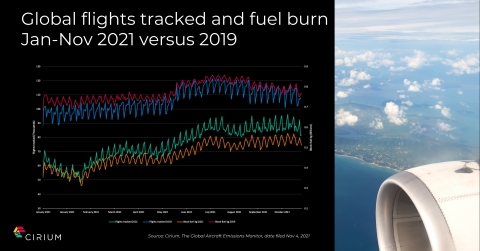New Airline CO2 Emissions Monitor From Cirium Reveals 40% Less Fuel Burnt From Flights Flown Globally In 2021
Cirium, an aviation analytics company, has launched its Global Aircraft Emissions Monitor, which offers precise measurements of CO2 emissions and fuel consumption for flights worldwide. The tool tracks that fuel burn in 2021 has decreased by 40% compared to 2019 due to a 29% reduction in flights. Despite recovery in air travel, a forecast suggests that by 2039, fuel burn could reach 485 million tons, translating to 1,530 million tons of CO2 emissions. The Monitor's unique data sources enhance its accuracy, achieving 1% validation in tests.
- Launch of the Global Aircraft Emissions Monitor provides invaluable data on emissions and fuel consumption.
- Fuel burn reduced by 40% in 2021 compared to 2019 due to fewer flights.
- Monitor validated for accuracy at 1%, enhancing reliability for industry stakeholders.
- Potential for strategic insights into emissions tracking and cost ownership for airlines and aviation stakeholders.
- Flight activity remains 29% down compared to 2019, indicating sluggish recovery.
- Projections suggest a significant increase in fuel burn and carbon emissions by 2039 without sustainable initiatives.
Insights
Analyzing...
- Cirium, the aviation analytics company, launches a Global Aircraft Emissions Monitor to accurately measure CO2 emissions and fuel consumption of flights flown globally, by aircraft type, flight, and tail number.
-
With fewer flights in 2021 because of COVID-19, the data shows that
40% less fuel was burnt versus 2019 year-to-date. -
Flights tracked year-to-date are
29% down versus 2019—airlines have flown aircraft fewer hours and brought back more efficient types. - 485 million tons of fuel burn are projected by 2039 based on the flight capacity of the forecasted growing fleet to meet future passenger travel demand.
- The new product fuses unique data sets that no other independent source can provide.

Cirium data shows the global flights tracked and fuel burn Jan-
New insights from Cirium show that airlines have burnt
The reduction in flight-produced carbon emissions is attributed to the drop in flights worldwide because of the dramatic impact that COVID-19 had on air travel. Flights tracked year-to-date are
The fuel burn has increased as domestic and international flights have started to return but not as much as expected compared to 2019—before the pandemic. The airlines have been flying their aircraft far fewer hours and prioritizing more efficient aircraft.
“To achieve the aggressive targets for aviation to reach net zero emissions by 2050, a thorough understanding is needed of all elements of an aircraft used for flights and the exact flight operations,” said
“Cirium’s Global Aircraft Emissions Monitor boasts data of the highest quality and validity. The need for greater sustainability is clear and Cirium is committed to supporting the industry’s decision-making based on accurate carbon emissions tracking.”
The uniqueness of the product derives from the data, which is obtained from the widest and deepest data warehouse in the aviation industry. No other independent source can provide calculations based on the same blended data sets. The Monitor’s custom data calculations are based on hundreds of flight and aircraft variables for maximum accuracy. These variables include actual flight and taxi times, cabin configuration, aircraft operating empty weight, assumed cargo tonnage, aircraft/engine type, winglet equipage, aircraft age and more.
Tests conducted on the Global Aircraft Emissions Monitor have validated its accuracy in the order of
The Global Aircraft Emissions Monitor includes customized options for CO2 emissions and fuel consumption. It applies complete profiles of actual flights and aircraft, which are fused with block fuel burn models.
While aviation has reduced its emissions overall this year, travel is recovering, with Cirium forecasts projecting for global recovery to 2019 levels potentially by 2023. Cirium’s Fleet Forecast also predicts that based on the flight capacity of the increasing fleet to be in service by 2039, fuel burn may reach 485 million tons. This equates to 1,530 million tons of CO2 emissions, excluding any initiatives for sustainable aviation fuels (SAF) or offsetting.
Carbon emissions and fuel consumption from flights are increasingly becoming the centre focus for all airlines, airports aviation finance, aircraft manufacturers, air traffic management, government, and fuel providers.
The comprehensiveness of the Cirium Global Aircraft Emissions Monitor will enable organizations to track emissions as a measure of efficiency, understand aspects of total cost of ownership, understand the profile of a current operator, gain a better understanding of the climate impact, benchmark the competition, and create fuel demand models.
Find out more at https://cirium.com/EmissionsMonitor.
-End-
For further information please visit https://www.cirium.com and follow Cirium updates via LinkedIn and Twitter.
About Cirium
Cirium brings together powerful data and analytics to keep the world moving. Delivering insight, built from decades of experience in the sector, enabling travel companies, aircraft manufacturers, airports, airlines and financial institutions, among others, to make logical and informed decisions which shape the future of travel, growing revenues and enhancing customer experiences. Cirium is part of RELX, a global provider of information-based analytics and decision tools for professional and business customers. The shares of
View source version on businesswire.com: https://www.businesswire.com/news/home/20211110005600/en/
For media enquiries please contact:
or the Cirium media team at media@cirium.com
Source: Cirium







